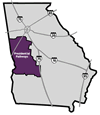
Wildlife Viewing Guide


|
Wildlife Viewing Guide |
 |
 Eufaula
National Wildlife Refuge, Bradley Unit
Eufaula
National Wildlife Refuge, Bradley UnitDescription: The Bradley Unit of this Refuge is a 700-acre highly manipulated wetland impoundment located on the banks of the Chattahoochee River known as Lake Eufaula. Water is removed by pumping in the spring and summer to allow wildlife food plants to grow and is added to the impoundment in fall and winter to flood these same plants to attract and feed waterfowl. There are some planted fields of corn and sorghum, along with old fields and islands of gum, willow, and wax myrtle. The unit is surrounded by a levee, and a cross levee separates the unit into two parts. The levees serve as great observation platforms
Viewing Information: Between late March and early July the rookery is home to or foraging ground for a variety of nesting wading birds. From about March 15 to June 1 the great blue herons and great egrets may be seen sitting on their eggs and delivering food to their young. Look for American anhinga nests also. By late June, the primary species nesting in the rookery are cattle egrets and little blue herons. Hundreds of cattle egrets may be seen at any time during the summer. sometimes wite ibis are observed in the colony, but it is doubtful that they nest there. Look for wood ducks, ring-necked ducks, hooded mergansers, American wigeons, pied-billed grebes, cormorants, American coots, common gallinules, and other water-dependent bird and mammal species in the flooded timber and freshwater marsh. Be observant of the American alligators at this site. There are several 12-foot-long males and several nests along the levees between May and July. A lucky visitor will see sand-hill cranes or wild turkeys feeding in the agriculture fields. Eastern bluebirds and loggerhead shrikes often perch on the power wires. Great-crested flycatchers, eastern phoebes, and marsh and sedge wrens use the dense stands of plume grass and sedges. In the hedge rows and wooded areas, prthonotary, yellow, magnolia and yellow-rumped warblers and common yellow throats are very active. Look for two silos that house barn owls, rock doves, and bats.
Directions: From Georgetown, GA, go north on GA Hwy. 39 about 9 miles to the Eufaula National Wildlife Refuge, Bradley Unit. Entrance sign on the left. Park there and enter by foot. From the check station, walk right and travel 1 mile along the levee to the heron and egret rookery.
Management: U.S. Fish and Wildlife Service, 334-687-4065
Closest Town: Eufaula, AL
Site Notes: parking, bicycles allowed
Additional Information: There are two locked gates to pass before you enter the unit. Apecial arrangements must be made to obtain a gate key to enter the unit by vehicle. Contatct the refuge office for details. Otherwise, you must enter the unit on foot. Allow 3-4 hours to hike the levees. Take plenty of drinking water and insect repellent.
![]()
![]()
![]()
![]()
![]()
Read and add comments about this page